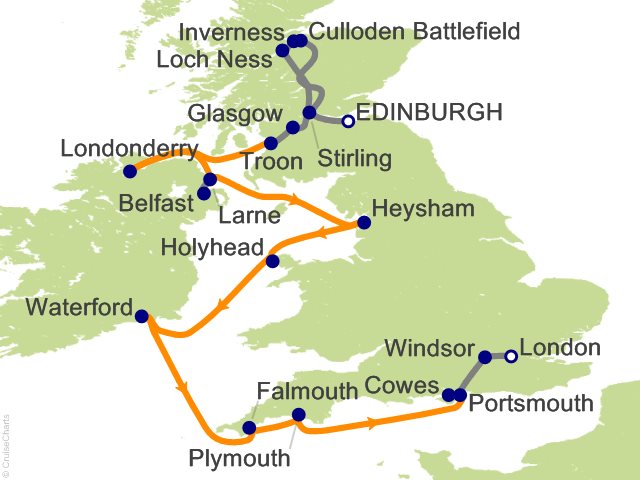We head north to 'clan country', for an overnight stay in its heartland: Inverness. The Highlands of Scotland invite us to explore Scotland's own monarchy, with an en route stop at the royal Scottish city of Stirling and the battlefields of Culloden. Perched atop Castle Hill, Stirling Castle stands as a symbol of Scotland's rich history and royal heritage. This grand fortress, once a favored residence of Scottish kings and queens, played a pivotal role in the Wars of Scottish Independence. It was the childhood home of Mary, Queen of Scots, and witnessed her coronation. The castle was central to the reigns of the Stewart monarchs, particularly King James VI of Scotland, who became King James I of England, uniting the two thrones for the first time. This union eventually led to the Jacobite uprisings and the demise of the clan way of life. Among other sites within the castle, we explore the magnificent Great Hall, Royal Palace, and Chapel Royal, all beautifully restored to reflect its regal past, while discovering the people and events that have shaped both the castles and Scotland's history. Our second stop today offers an insight into the clash of the clans and their British rulers, brought alive this afternoon by our local guides. Scottish clans played significant roles in Scotland's history and politics. Their relationship with the British crown was complex, marked by alliances and conflicts. The clans often supported different royal factions, notably during the Jacobite uprisings in the 17th and 18th centuries, when many clans backed the Stuart claim to the British throne. The defeat of the Jacobites at the notorious Battle of Culloden marked the end of the clan's power. Subsequent British policies, including the Highland Clearances, dismantled the clan system, by banning tartan, the Gaelic language, bagpipes, and the communal style of living that the clans had enjoyed for centuries. By integrating Scotland more fully into the British state, English rule diminished the clan influence. Today, the clans' legacy lives on in Scotland's culture and heritage, with clan gatherings and tartans celebrated worldwide. Our guided visit to the battleground of Culloden offers a poignant reminder of the bitter feud between the clans and the crown. The Battle of Culloden, fought on 16 April 1746, was the final confrontation of the Jacobite rising, with the fighting resulting in a decisive defeat for the Jacobite forces led by Charles Edward Stuart (Bonnie Prince Charlie) at the hands of the British government troops commanded by the Duke of Cumberland. The estimated number of casualties varies, but it is generally accepted that around 1,500 to 2,000 Jacobites were killed or wounded during the battle, with those who survived being either imprisoned or executed. In contrast, the heavily armored British government forces suffered significantly fewer casualties, with around 300 killed or wounded. Standing on the ground where the battle was fought affords us an insight into the brutal manner of 18th-century warfare and its everlasting legacy. Our overnight stop is in the Highland capital of Inverness. Deeply intertwined with Scotland's rich clan culture, Inverness is the spiritual home to clans such as the MacDonalds, MacLeods, and Frasers, who played pivotal roles in shaping the region's history and identity. From battles fought to alliances forged, these tight-knit family groups lived a feudal lifestyle, with dedication to their 'laird' upmost in their minds. Inverness itself served as a strategic clan stronghold and hosted gatherings that defined Highland life, with annual celebrations such as clan reunions and the Highland Games, celebrating traditional sports and music, keeping alive the legacy of Scotland's vibrant clan culture. We gather tonight for dinner, where our host will enthrall us with tales of past clan clashes and how they continue to influence 'the highlands' 21st-century lifestyle. Accommodation: Royal Highland Hotel Inverness ...
Read More




 Track this Cruise.
Track this Cruise.  Favorite this Cruise and receive Price Alerts when the rates go up or down.
Favorite this Cruise and receive Price Alerts when the rates go up or down.

















